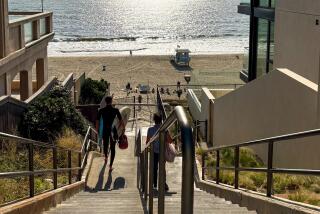Historian Delivers the Word on Balboa Pavilion
- Share via
Dear old Jim Sleeper, the sage of Trabuco Canyon and veteran Orange County historian, has kindly straightened me out on the history of the Balboa Pavilion, now festively festooned with Christmas lights.
I previously reported here that the Pavilion was built in 1905. This is a year too early, Sleeper says.
There was no way to get to Balboa in 1905, “except by rowboat or shank’s mare,” he says.
“To be sure, ‘talk’ was in the works before any sticks went up. As early as January of 1905, plans were announced to build a $10,000 boat house. More talk followed on June 20, 1905, when the developers pledged to put up this $10,000 pleasure palace on the bayside and install cement walks throughout the tract.
“However, materials would not start arriving until late that year. Plans drawn by architect Fred R. Dorn of Los Angeles were finally revealed on Jan. 20, 1906. As originally conceived and largely built, the Pavilion was to stand on 160 piles coated with three inches of ‘cement stone.’ Downstairs it was to contain 70 dressing rooms; upstairs, a dance hall 50 by 100 feet. A 10-foot open balcony originally ran around the upper floor, but was later enclosed to add to the ballroom,” Sleeper discloses in a letter to me.
Sandstone Courthouse
The contractor was Chris McNeill, who five years earlier had built Orange County’s old red sandstone courthouse in Santa Ana. Cost projections for the Pavilion at this point were $13,000. The building ran $1,000 over budget.
Imagine building a grand structure like that for $14,000! And it’s still standing, which says something about the old ways of putting wood together.
Sleeper reports that in preparation for the Pavilion’s construction, a stubby wharf had been built just north of the site. Here, he says, materials were barged down the bay from a point that later become the “County Dock” near where The Arches restaurant now stands. The old Santa Ana-Newport Railway, now the Southern Pacific, still ran, but Newport Wharf (where the Newport Pier now is located) and the old sailing and steamer traffic of earlier years virtually died in 1899 when the McFadden brothers sold both their wharf and the railroad. Thereafter, all shipping was diverted to San Pedro and other points.
“Until 1920, when the Santa Ana River was channeled directly out to sea, it flowed down the coast, along the bluffs below Hoag Hospital, through the passage that became the overpass, and hence emptied into the lower bay. With help from a little motor power and much poling, the stream helped carry lumber barges to their destination. That is, to the stubby wharf just above the Pavilion,” according to Sleeper.
First Passenger Car
Speaking of the Pavilion’s 10th anniversary, Sleeper declares that the Pavilion’s first manager, Fred Beckwith, reminisced on its opening. The date: Sunday, July 1, 1906--three days before the Pacific Electric Railroad’s first passenger car arrived. The opening of the Pavilion was planned to coincide with the arrival of the first Pacific Electric car, whose tracks ended in front of the Pavilion.
“No need to say that without the trolley, business was somewhat slack. On the first Sunday, the Pavilion earned, or rather took in, $2.40 for Mr. Beckwith and his associates. Also that same Sunday, two bathing suits, valued at $2.75, were stolen!”
Three days later, the street cars arrived; the Knights of Pythias threw a winger of a Fourth of July picnic at the beach, and that night held a dance that christened the Pavilion’s floor.
“With that, Balboa was truly born!” concludes Sleeper.
Mystery Cleared Up
Sleeper also has cleared up a mystery I’ve tried in vain to solve from other local historical sources. For the last couple of months I’ve been delving into local Newport Harbor history and the history of Santa Catalina Island in preparation for a book I’m writing on the circumnavigation of Catalina in my sloop Herald Bird. I was pretty sure, but I couldn’t pin it down, that hunks of Catalina formed the twin jetties of Newport Harbor’s channel mouth.
Sleeper assures me that the jetties’ rocks were quarried on Catalina and barged here.
It’s a nice little thing for a yachtsman to know. He leaves the mainland between a pair of sheltering arms from Catalina, and his first landfall 27 nautical miles later is the rugged old rocky island itself.
Thank you, Jim.
More to Read
Sign up for Essential California
The most important California stories and recommendations in your inbox every morning.
You may occasionally receive promotional content from the Los Angeles Times.













